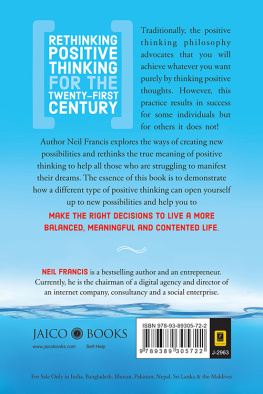The Participation Revolution
Neil Gibb is a consultant, writer, speaker, and social advocate. He has spent his whole career looking at how new thinking and technology can be applied to improve business and society. Today he works with companies and organisations, helping them transform to thrive in the new economy. He also works with social enterprises, start-ups and recovery communities.
This book was a decade in the making, based on experience working in Europe, North America, Australia, Asia, and South America.
Its about transformation about the emergence of a new social and economic paradigm.
It is designed as a manifesto for those who are out to change the world.
It provides a framework for transformation in the new economy.
And for anyone who might be interested, it shows you how to be a billionairein three easy moves.
The
Participation
Revolution
How to ride the waves of change in a terrifyingly turbulent world
Neil Gibb
Published in 2018
by Eye Books
29A Barrow Street
Much Wenlock
Shropshire
TF13 6EN
www.eye-books.com
ISBN: 978-1-78563-055-2
Copyright Neil Gibb 2017
All rights reserved.
The moral right of the author has been asserted.
No reproduction without permission.
Cover design by Heath Kane
Cover photograph by Bernie de Chant
Edited by John Ciavarella, Simon Edge, Clio Mitchell
Typeset by Clio Mitchell
www.neilgibb.com
www.transformation.ist
British Library Cataloguing in Publication Data
A catalogue record for this book is available from the British Library
Printed by CPI Group (UK) Ltd, Croydon CR0 4YY
I would like to acknowledge Eric Hutcheson, whose incredible life story, and mentoring, encouraged me to set off on the journey of discovery that led to this book. And Simon Fenton, whose friendship and support throughout my journey was so precious and who, tragically, died while the book was in preparation.
Thanks to Sarah Baxter, Sandy Rappaport, Robert Power, Mal Gibb, Josh Samuels, Nancy Nguyen, William Morgan, Kirsty Donovan, Erica Szabo, Nick Rimmer, Ed Tota, Julian Kell, Ira Rahmad, Philea Adhanti, Melody Briggs, Valeria Gonzales, Amanda Noga, Mei Lai Swan, Annie Belcher, Howard Johnson, Cindy Moussi, Christine Seale Nielsen and a whole load of other people I met along the way.
Also thanks to Suzanne Stein for both the term and philosophy of deep hanging out when we were working at Sapient.
In memory of Simon Fenton (1970-2017)
Writer, explorer and pioneering social entrepreneur
Prologue
Saturday 16 September 2008, Regents Street, London
The bright, hazy late-summer sun is beginning to dip in the sky, slanting a dark shadow across the elegant white-fronted Regency buildings that make up one of Londons chicest retailing thoroughfares.
A rare balmy summers day has bathed Regent Street in a dreamy, lazy ambience. On the wide pavements, the crowds have started to thin as afternoon cruises towards evening. People are meandering rather than the usual pushing and shoving.
About halfway down the west side of the street, in a patch still drenched in sunlight, theres a very different vibe. A scrum of people is pushing to enter a store-front door. Its a stark contrast to the relaxed feeling on the rest of the street. The expression on some of their faces is somewhere between panic and desperation.
This is the doorway to Apples first flagship European store. The shop has been jammed with customers since it opened two years ago, but today it is particularly frenetic the new iPhone 3 has just been released. Inside has the air of a fire sale. Sales assistants in blue T-shirts snake through the crowd, often with two or three customers vying for their attention.
Over by the iPhone demo area, a woman in her mid-30s is looking around frantically. She has been in the store for over half an hour, desperately trying to get the help of a sales assistant. Just as she is about to give up, and relinquish the demo model she is clutching, a thin young man emerges from the crowd, smiles, and starts to talk to her. Within minutes they are deep in conversation she hanging on his every word, and he enthusiastically showing her how the phone works.
Across the street, things couldnt be more different. A hundred meters up towards Oxford Circus, a blue Nokia sign, lit by the late rays of the sun, hangs over a doorway that clearly doesnt have a scrum outside it. This is the home of Nokias own new concept store. At a cost of over 4 million for its elegant fit-out alone, with a state-of-the-art translucent interactive wall, and a hip-looking lounge area, its been designed to take the fight to Apple. Inside, good-looking, well-groomed, and well-trained assistants are aplenty. While Apple is a one-phone wonder, Nokia is the worlds number one mobile phone maker. The racks in the store are resplendent with a range of cool-looking, well-designed smartphones, the top-end ones every bit as good as the iPhone in terms of functionality. What is more, Nokia has a proven track record in mobile communications and bulletproof reliability, while Apple is the new kid on the block with a somewhat patchy record when it comes to battery reliability in its smaller devices.
This should be a winning proposition.
But the Nokia store is practically empty. While customers in the Apple Store are pleading for sales assistants attention, here they are acting far more consistent with the UKs cultural stereotype: friendly offers of help are at best met with a tight-lipped No, thank you and at worst by customers just marching out of the shop empty-handed.
By the end of 2009, with Apples sales booming, and its stock price heading into outer space, new Apple Stores were popping up all around the world each time heralded by the kind of mania that used to be reserved for pop bands like the Beatles.
Meanwhile, the Nokia flagship store on Regent Street quietly closed.
By 2012, Apple had displaced Exxon Mobil as the worlds most valuable company. And in China, a particularly odd thing happened: a bunch of counterfeit Apple Stores were discovered. Yes, counterfeit stores shops designed to look like Apple Stores. Everyone, it seemed, wanted a part of Apple.
Meanwhile, Nokia was a company in crisis. In April 2012, it announced it was cutting 7,000 of its workforce, and another 2,500 jobs were slashed later in the year.
The question on every analysts lips was obvious: why did these two high-tech giants with equally fantastic products and reputations for innovation have such radically different fortunes?
People pointed to design, and leadership, and a whole host of other internal factors.
But they all missed a critical point.
The answer didnt lie inside the companies, but with that young man who approached the woman customer in the Regent Street Apple Store and started to help her with her phone. He wasnt an Apple sales assistant or employee he was just a kid off the street; another shopper.
Why was it that in the Nokia store, where there were great products, free coffee, loads of space, and plenty of attentive sales assistants, customers were running out of the shop without a new phone, while in the crowded Apple Store other shoppers were actually prepared to help one another out?
In answering this question, we not only find what it takes to build successful businesses in the emerging new-world economic order, we actually have the answer to what it is going to take to successfully rebuild our societies in the networked age.
Contents
Tomorrow belongs to those who can hear it coming












